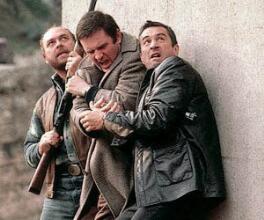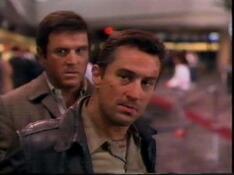Cinematic Pleasures: Midnight Run
by j.d. lafrance
 One of the most popular trends in the 1980s was the buddy-action movie. The best films to come out of this period were Beverly Hills Cop (1984), 48 HRS (1987), Midnight Run (1988), and Lethal Weapon (1989), which spawned numerous imitators and sequels. Along with Lethal Weapon, Midnight Run is arguably the genre's last gasp before slipping into formulaic predictability and self-parody (see Rush Hour, Blue Streak, et al). What makes Midnight Run so good, even after all these years, is the unbeatable combination of an excellent cast, a witty script and solid direction.
One of the most popular trends in the 1980s was the buddy-action movie. The best films to come out of this period were Beverly Hills Cop (1984), 48 HRS (1987), Midnight Run (1988), and Lethal Weapon (1989), which spawned numerous imitators and sequels. Along with Lethal Weapon, Midnight Run is arguably the genre's last gasp before slipping into formulaic predictability and self-parody (see Rush Hour, Blue Streak, et al). What makes Midnight Run so good, even after all these years, is the unbeatable combination of an excellent cast, a witty script and solid direction.
Jack Walsh (Robert De Niro) is a bounty hunter hired by his bail bondsman (Joe Pantoliano) to find and transport to Los Angeles, one Jonathan Mardukas (Charles Grodin)--aka "The Duke," an accountant who stole $15 million from a Las Vegas gangster (Dennis Farina). What is initially a simple "midnight run" from New York City to Los Angeles turns into the road trip from hell as Walsh and Mardukas are pursued across the country via plane, train, and automobile by dim-witted gangsters, frustrated FBI agents, and a rival bounty hunter.
Fresh from his scene-stealing appearance in The Untouchables (1987), Robert De Niro was eager to try something different. He wanted to do a comedy and to this end, pursued the lead role in Penny Marshall's film, Big (1988). Marshall was interested but the studio was not and thankfully the role went to Tom Hanks.
Martin Brest, who directed Beverly Hills Cop, had found another script by George Gallo in the same vein--one that blended elements of comedy and action. He sent it to De Niro and was very up front with the actor: Midnight Run was a commercial film not an in-depth character study.
 Paramount was originally interested in backing Midnight Run, but they wanted a big name star opposite De Niro in order to improve the film's chances at the box office. Their production executives suggested that the Mardukas character be changed to a woman and wanted Cher for the role in the hopes that she would provide some "sexual overtones."
Paramount was originally interested in backing Midnight Run, but they wanted a big name star opposite De Niro in order to improve the film's chances at the box office. Their production executives suggested that the Mardukas character be changed to a woman and wanted Cher for the role in the hopes that she would provide some "sexual overtones."
Brest wisely rejected the idea and so Paramount suggested teaming De Niro up with Robin Williams. Williams was a big star in his own right and eager to get the role. He even offered to do an audition for Brest--a rarity for the comedian whose name alone could green light projects. However, Brest was impressed by Charles Grodin's audition with De Niro. The director felt that there was a real chemistry between the two actors. As a result, Paramount backed out and Universal became interested in the project. It is to Brest's credit that he supported Grodin down the line and refused to change his decision despite studio pressure.
Filming began on October 26, 1987 with a budget of $30 million. The crew shot in a variety of locations all over the United States, ranging from Chicago and Las Vegas to New York City and Los Angeles.
Midnight Run adheres to the basic formula of the buddy-action film with two diametrically opposed characters teaming up to fight the bad guys. Inevitably, humourous situations arise from constant bickering while the duo shoots, punches, and fights their way out of action-packed set pieces.
Ultimately, what makes Midnight Run work so well is how it messes around with the formula. Instead of having one funny guy and one straight man, you have two straight men with De Niro and Grodin. And yet it works, due in large part to the skill of the two leads who compliment each other perfectly--De Niro plays Walsh as a gruff, foul-mouthed guy constantly annoyed by Grodin's clean-cut accountant, armed with a seemingly endless supply of personal questions to ask his traveling companion. Their scenes together seem very spontaneous and real as they annoy the hell out of each other.
Brest brought Grodin aboard with the understanding that the actor would have the opportunity to improvise. Grodin was very much open to De Niro's improvisational technique. He remembers that De Niro "was all about 'work,' plain and simple, and being with him felt like breathing pure oxygen." Some of their best scenes feel like the script was just thrown out and that they simply riffed off one another. For example, the night boxcar scene where Walsh and Mardukas bond, after illegally stowing away on a train, was improvised entirely.
 Much of the film's humour comes from these moments as they constantly antagonize each other. This relationship is believable because the film takes the time to develop it with many scenes where the two men just talk, and this allows us to get to know them. Most buddy films spend only the bare minimum amount of time on character development and instead cram as many action set pieces and explosions in as possible. As a result, we do not become attached to the characters. Midnight Run does not fall into this trap.
Much of the film's humour comes from these moments as they constantly antagonize each other. This relationship is believable because the film takes the time to develop it with many scenes where the two men just talk, and this allows us to get to know them. Most buddy films spend only the bare minimum amount of time on character development and instead cram as many action set pieces and explosions in as possible. As a result, we do not become attached to the characters. Midnight Run does not fall into this trap.
For all of its commercial elements, George Gallo's screenplay has very strong, three-dimensional characters that transcend their stereotypes. It was the screenplay that first drew Grodin to the project. He said in an interview that "the script had dimension beyond what I'm used to seeing. The dimension of character. It looked like a good action-adventure genre picture with strong character evolution." De Niro, being the consummate actor that he is, still manages to inject little touches and details, like a habit of constantly checking his faulty watch, that provide insights into his character. Brest commented in an interview that, "sometimes I'd let the camera run after finishing a scene to see if he did any bits, and invariably he did."
From the two leads to the rest of the supporting cast, each character is given a moment or two to say or do something that makes them distinctive and funny. For example, there is Marvin Dorfler (John Ashton), a rival bounty hunter who falls for the same stupid trick every time, or the weasely bail bondsman (Joe Pantoliano) who cares only about money and his reputation. These characters could have been presented as cliched stereotypes but Brest wisely casts veteran character actors like Ashton and Pantoliano in these roles. Dorfler is no longer just some generic bounty hunter. Ashton transforms him into a self-absorbed idiot who is completely oblivious to the big picture. Even though Dorfler is always on the receiving end of many jokes, he gets his chances to prevail. However, you know that, ultimately, he is destined to fail. Dorfler has a distinctive personality instead of being merely a cardboard cutout. And this goes for all of the supporting characters, once again proving the old adage that casting is everything.
Many of the supporting characters appear constantly throughout the film in a series of running gags. Whether it is Walsh's continuing impersonation of FBI Agent Walter Mosely (Yaphet Kotto) or the two dim-witted mobsters' pathetic attempts to find Walsh and Mardukas, these gags appear time and time again at just the right moments for maximum comic effect and are never overused.
When De Niro did Midnight Run he was not known for doing comedies. Up to that point he had only done The King of Comedy (1983) and Brazil (1985) Now, there is a whole generation of filmgoers that only knows him from comedies like Meet the Parents (2000) and Analyze That (2002). Charles Grodin has, for the most part, shunned the limelight. He had a short-lived talk show and appears occasionally on The Tonight Show with Jay Leno but has, unfortunately, not done anything on par with his work in Midnight Run. In fact, he hasn't acted since 1994 and said in an interview with The Onion that he has quit acting altogether.
By the late '80, early '90s, the buddy-action film had become a tired and hackneyed cliche. Screenwriter Shane Black offered a brief breath of fresh air with Lethal Weapon (1989) and The Last Boy Scout (1991) but generic time-wasters like De Niro's own Showtime (2002) or Serving Sara (2002), which blatantly rips off Midnight Run, are still cranked out with predictable regularity by the studios.
Copyright (c) 2005 erasing clouds |
|